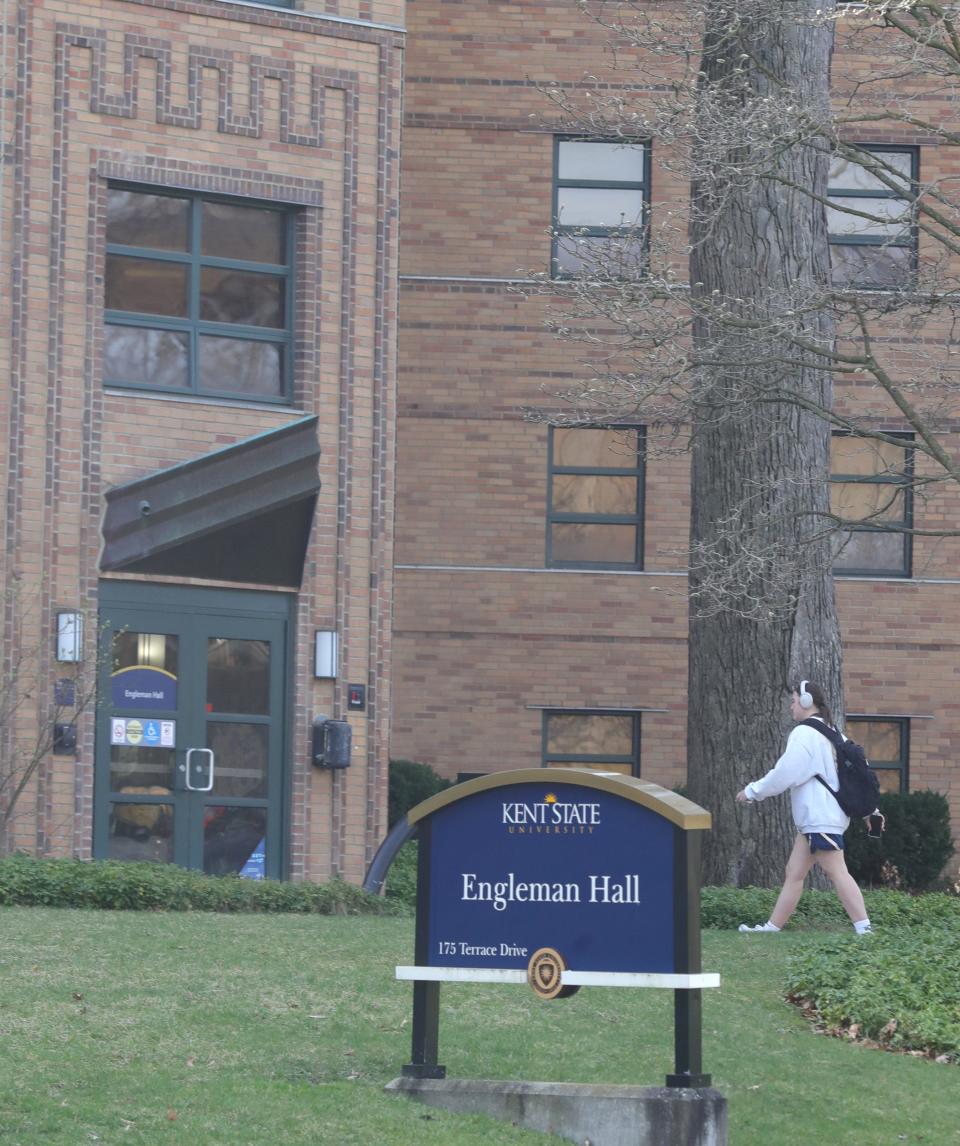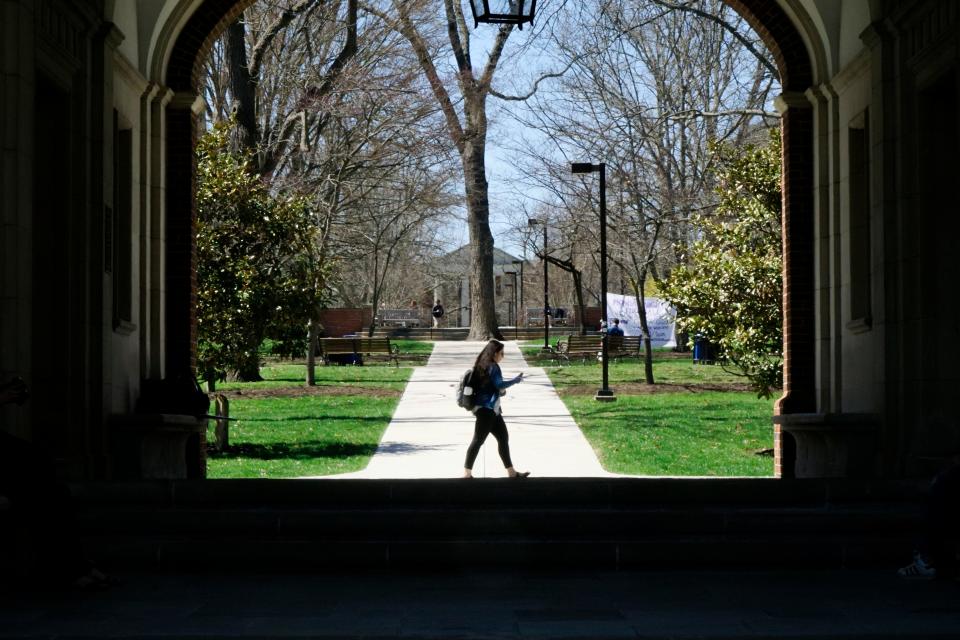Ohio public universities face massive budget cuts. Here's what's at risk

- Oops!Something went wrong.Please try again later.
Seated behind his office desk last month, Kent State University President Todd Diacon had a blunt report for the hundreds of faculty and staff members watching his monthly "Talking with Todd" webcast.
The university ended the 2023 fiscal year with a $1.4 million operating budget surplus — several million dollars short of its goal — and to remain financially viable, Kent State must make multimillion-dollar budget cuts each year for the next four years.
“We are not asking people to do more with less,” Diacon told Kent State faculty and staff in February. “We will have to do things differently, not more with less, but do things differently.”
Higher education: Enrollment tumble puts Ohio State University's regional leadership search in focus
Kent State isn't alone in needing to do things differently.
A number of public and private universities across Ohio and the country are facing steep deficits.
Penn State University plans to cut $94 million from its budget next fiscal year, a change its leaders say will move the university toward long-term stability. The University of Arizona announced a $177 million budget shortfall in January and a plan to "right size" through hiring freezes and budget cuts. Faculty layoffs and discounted degree programs are a result of West Virginia University's $45 million budget shortfall and declining enrollment, President E. Gordon Gee said last year.
Public universities aren't alone in their struggles. Baldwin Wallace University, a Northeast Ohio private university, announced in January that what administrators thought was a $3 million budget deficit accrued during the last fiscal year actually totals more than $20 million.
Diacon said unlike Ohio State University and the University of Cincinnati, most of Ohio's other public universities are in similarly precarious financial situations to Kent State.
"With one or two exceptions, all public universities in Ohio are either dramatically reducing spending to create balanced budgets like we're doing or they're running deficit budgets," he said.
How fiscally fit are Ohio's public universities?
Kevin McClure, an associate professor of higher education at the University of North Carolina Wilmington and an expert in higher education finance, said institutions can be divided into three broad categories: schools that are doing great financially, schools where the budget is doing fine but things are tight, and schools that are in a structural deficit.
"The reality is the vast majority of Americans attend an institution in that middle section," McClure said.
"There's a common misconception that all higher education is like the Ivy League with massive endowments and when things are hard you just tighten the belt a little," he added. "There are many institutions where there just isn't that much more belt to tighten."
The Ohio Department of Higher Education requires all of the state's public institutions to provide year-end audited financial statements to increase financial accountability.
Composite scores between 1 and 5 are calculated by averaging three ratios: viability, primary reserves, net income. A composite score of 1.75 or below for two consecutive years would result in an institution being placed on fiscal watch.
The average composite score in fiscal year 2022 was 3.5.
Many institutions saw a bump in their composite scores during fiscal year 2021 as schools saw an influx in state and federal money during the COVID-19 pandemic to stay afloat. McClure said a lot of schools were able to avoid cuts because of that stimulus money.
"Now," he said, "that cushion is not there."
'Ohio has an overbuilt higher education infrastructure'
Higher education headwinds have made maintaining balanced budgets more challenging.
"We never finish in a deficit," Diacon said of his first years as Kent State's president. "What's changed is how hard that's been to do."

In this current fiscal year — which runs from July 1, 2023 to June 30, 2024 — Kent State reduced its projected spending by $18.4 million, about 3% of the university’s annual budget, according to Diacon.
Beginning in fiscal year 2025, the university will need to reduce spending by another $17 million. Cuts will continue for the following three fiscal years: $7.8 million in fiscal year 2026, $17.3 million in fiscal year 2027 and $26 million in fiscal year 2028.
Some of those cuts will come from reorganizing leadership at Kent's regional campuses, consolidating colleges and academic programs, and layoffs.
"I'm not going to sugarcoat this. We will have to reduce the number of employees at Kent State," Diacon said during his monthly webcast.
Miami University is in the process of enacting a new strategic plan to try and avoid some of these negative trends, said David Creamer, senior vice president for finance and business services Creamer said Miami finished the year with a balanced budget and "is not expecting to see any diminishment in its overall financial condition" this fiscal year, but the university is generating smaller surpluses than it used to.
"However, if we do not address these challenges now, they could become a problem," he said. "Universities need to adapt."
Miami pulled more than $16 million from its reserves and planned to offset another $20 million by keeping some staff positions unfilled. The university is considering cutting 18 low-enrollment academic majors, and it laid off 13 staff members last year.
Creamer said "the recent repurposing of resources from low enrolled programs" saved Miami $4.2 million, which he said will be reinvested in in-demand areas of growth and where the state has identified unmet needs.
Cleveland State University previously reported an expected $34 million budget deficit to end this fiscal year; that has since been reduced to $11.5 million to be covered by reserves. Youngstown State University is eliminating five programs and cutting 13 faculty positions, mostly in the humanities, and the University of Toledo plans to reorganize 48 of its majors to reduce costs.
Central State University announced it will need to take immediate action to balance their budget as the 2024 fiscal year comes to an end. The university is projecting a $4 million shortfall, about 6% of their total operating budget, due to overspending for several years using Higher Education Emergency Relief Funds for recurring expenses.

Administrators at these institutions cite a number of culprits: inflation, lower domestic and international enrollment, shrinking high school classes and less state funding, to name a few.
Diacon summed up the complex higher ed quandary: "Ohio has an overbuilt higher education infrastructure."
Ohio universities built out their campuses during enrollment growth in the 1960s and 1970s. Now, some schools are feeling the weight of that growth. McClure said there are regions like Ohio that have seen "real structural changes to population, jobs and opportunities" over the last 40 years that directly affect universities.
Birth rates in the U.S. continue to fall, meaning high school class sizes are getting smaller. With fewer traditional-aged high school students going to college, McClure said institutions are fighting each other for the same shrinking group of students.
One way to win those students is by offering better financial aid packages. Although tuition continues to rise, revenue gained from tuition is falling at many colleges as they offer competitive scholarships.
Diacon said Kent State spent $72.8 million in student aid this year. In 2009, the university spent $20.4 million on a freshman class of a similar size.
Despite record enrollment, Miami made less from tuition revenue in 2021 than in 2001. Todd Stuart, Miami's director of arts management and entrepreneurship, said at the university's budget symposium last February that it's "the (tuition) discount that’s really killing us."
University of Akron hopes to turn corner from enrollment cliff
The University of Akron is also bracing for this “enrollment cliff” due to demographic shifts, Vice Provost for Enrollment Management Steve McKellips said, but may also be ahead of the curve.
The university has already seen its enrollment drop precipitously, and has made adjustments as a result. Those adjustments included an effort to right-size the university, laying off dozens of faculty and staff in 2020, and combining colleges.
It also included efforts to increase enrollment and student retention, from offering more student supports to giving adult students course credit for prior learning, including past work experience.
“We feel as though we have done the corrections that are kind of bringing the university the stability that it's looking for,” McKellips said.
The university last fall had 14,995 students, down by almost half of what it was a decade prior.
Leaders have also impressed upon those across campus that enrollment is everyone’s responsibility to help with, whether it’s being a friendly face for a visitor on campus or checking in with current students who may need supports to stay in school.
“We're really excited about being able to kind of, you know, stem the tide a little bit to be able to say, now we feel like we've kind of anchored ourselves for a while,” McKellips said. “And after a long decade, this feels like the best news the university’s had in a generation or two.”

What's at stake?
As universities stare down their financial futures, McClure said the question every leader will ask is "How do we thoughtfully contract?"
Some of that will include layoffs and painful restructuring. He applauded Kent State for its transparency, saying it gives faculty time to digest.
It could also include consolidation and sharing resources. Diacon said Kent State is already doing some of that work with Northeast Ohio Medical University and Youngstown State.
The most sustainable change though could come from state investment in higher education, Diacon said.
In the current biennial budget, Ohio lawmakers set aside more than $1.6 billion for public universities' State Share of Instruction, a 1% increase over the previous budget. Schools get a cut of that funding based on a formula that considers factors like course completion and degree attainment.
Some of Ohio's neighbors are reinvesting in their state's public university systems. Diacon said that funding could look like an increase to state share of instruction funding or one-time funding, like a subsidy to tear down old buildings as a cost-saving measure.
"The state can make meaningful differences," he said.
In his February webcast, Diacon fielded some questions from faculty and staff. Some thanked him for his candor. Others questioned if he would stick around to see these changes through. Diacon said he's not going anywhere, and neither is Kent State.
"We know where we need to go. We're going to get there," Diacon said. "We're going to thrive while others struggle."
![Construction continues at the Crawford College of Business and Entrepreneurship at Kent State University on Tuesday, March 12, 2024, in Kent, Ohio. [Phil Masturzo/ Beacon Journal]](https://s.yimg.com/ny/api/res/1.2/XXC5hSQO_xEMh4mcBX4r3A--/YXBwaWQ9aGlnaGxhbmRlcjt3PTk2MDtoPTEyNjQ-/https://media.zenfs.com/en/the-columbus-dispatch/f2bb0149a86a3056d89b3f26efe05f5a)
Sheridan Hendrix is a higher education reporter for The Columbus Dispatch. Sign up for Extra Credit, her education newsletter, here.
shendrix@dispatch.com
@sheridan120
This article originally appeared on The Columbus Dispatch: Ohio state-run universities face multimillion-dollar budget cuts

